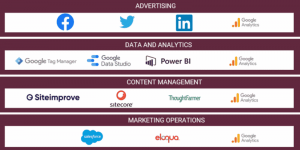As we head into 2016, I asked several marketing leaders to tell me what they think will be important for small businesses to consider as they’re planning marketing, sales and their overall distribution strategies. From my point of view, now more than ever is the time for small businesses to embrace digital marketing and take these tactics to the next level with personalization. Offline events, networking and sales will compliment how businesses execute their marketing. Gone are the days of viewing B2B and B2C as different channels. Everyone uses social media and everyone is on a mobile device. Decision makers are no different than the consumer – finding that balance for your business will be critical in 2016. Here’s what local marketing leaders in our community think 2016 will mean for marketing.
Focus on Website and Online Marketing Strategy
Kori Ashton
CEO at WebTegrity
Kori Ashton is the CEO and Lead Instructor of WebTegrity in San Antonio, Texas. She has more than 15 years of experience as an online marketing specialist, graphic designer and web developer.
About WebTegrity: WebTegrity is an award-winning web development firm located in San Antonio. They provide a Digital Creative Learning Center to teach WordPress web development, SEO, content writing and social media marketing.
Targeting Will Be More Precise
Rick Hill
VP of Marketing & Communications at Valero Alamo Bowl
Small businesses have never had more affordable access to advertising platforms and technological companies selling smart solutions to help them connect with customers efficiently. Targeting will get more precise in 2016 to help lessen the risk of buying ads. The adoption of cost-per-second billing will let me know if our ads are being watched, geo-targeting can serve our ads up to football-hungry fans sitting in certain stadiums and we can now even get real-time responses to ads based on facial recognition.
However, don’t be distracted by the shiny pennies of new technology and vanity statistics. Put more emphasis on accountability matrices before each campaigns starts and use desired conversions as the measure for success.
Also, remember, just because you can pinpoint where the fish are doesn’t mean you will be able to reel them in. No one wants their experience interrupted, (think how fast you try and X out of ads on mobile) so native advertising and experiential marketing will continue to grow. Focus on enhancing your customer’s on- and off-line experiences as well as ways to build your own database because your audiences on social platforms should be considered rented.
Rick Hill is the VP of Marketing & Communications at the Valero Alamo Bowl. He has over 20 years of experience creating marketing programs, events and engaging content for the bowl and preciously with the San Antonio Spurs. Interact with him on Twitter and LinkedIn.”
About Valero Alamo Bowl: This non-profit organization features an expansive collection of events and digital marketing programs throughout the college football season that culminate with a postseason game featuring the #1 selections from the Big 12 and Pac-12 after the College Football Playoffs.
Be Ready For Changes
Lara August
Founder and Creative Director of Robot Creative
In 2016, SMBs will still struggle to get up to speed with the huge mobile and digital changes of the past year and a half. With Google’s mobile algorithm changes, mobile-friendly websites have become a requirement. For most small businesses, a website upgrade will be a significant line item in the budget, and also a comprehensive project that will demand a challenging amount of time and input from the owners and upper management. In conjunction with the mobile changes, SMBs will have difficulty keeping up with the expanding digital marketing options. As all digital marketing (and specifically social media advertising) grows in complexity, specialized skills and training will be needed to manage these mediums effectively. In-house departments will struggle to manage comprehensive programs, and outsourced firms will have difficulty positioning themselves in most mid-size markets. Business owners should watch out for long-term contracts and require results that tie directly to business goals and not just reach and frequency. Businesses that can make these mobile/digital leaps quickly have the opportunity to reach audiences using the latest behavioral and re-marketing tools. It’s a fleeting chance to gain significant online market share while these mediums are still in their infancy.
Lara August is the Founder and Creative Director of Robot Creative in San Antonio, Texas. She has 20 years of brand strategy and SMB marketing experience.
About Robot Creative: Founded in 1998, Robot Creative is a boutique creative firm in San Antonio, Texas. We help build memorable brands and generate visibility results for companies seeking growth. We work locally with some of the most rapidly growing firms in the region, providing design, marketing, websites and social media.
Research, Research, Research!
Jessica Massay
Marketing Consultant and Consumer Strategist of JUMP Insights + Planning
“Research is to see what everyone else has seen, and to think what nobody else has thought” – Albert Szent-Gyorgyi.
Small businesses are often fueled by intense passion, determination and grit, but research? That’s a different story. Often small businesses operate without the necessary market research because they simply don’t have the time or resources to get it done! Sometimes, when business is good, there doesn’t seem to be a need for research.
The thing is, research done right will not only provide a solid learning foundation for small businesses; it can uncover new areas for growth and profitability. For starters, small businesses should use market research to have a solid understanding of the 4C’s – customers, competitors, context and core. The first three are fairly self-explanatory – businesses should know their target and reach customers, their key competitors inside and outside their category and the social, economic and cultural context in which they operate. Most do a good job with the three C’s and miss the fourth – core.
Core is all about you! It’s about what is at the core of your business and brand. Small businesses need to know their brand vision, mission and values and be able to effectively communicate them to both staff and customers. Beyond that, basic tools like SWOT analyses and branding ideation sessions can help small businesses to hone in on their competitive advantages and USP (unique selling proposition). Using both primary and secondary research to understand how customers use your product or service is key to refining your offer, identifying compelling price points and uncovering unmet consumer needs – all of which drive profitability and growth.
The next time market research seems to be an “extra” item on your priority list, consider that it may just be the key to uncovering the next best thing for your business.
Jessica Massay is the In-house Marketing Consultant and Consumer Strategist at JUMP Insights + Planning. She has led her own marketing consultancy for the past 9 years. She prides herself on deep-diving into business problems and using both data and insights to find real solutions. She has led strategy, consumer, brand and creative development for marketing initiatives across a broad range of categories.
About JUMP Insights + Planning: An experienced planning and research group, focused on providing brand planning and research services to a range of national and local clients. They firmly believe that data, gut, imagination and insights work together to build brands that people want to love.
Let Social Media Work For You
Whitney Lewis
Director of Communications & Public Affairs at North SA Chamber
One of the best things about social media is that it evens the playing field for small businesses who have a lot to accomplish with limited resources. It gives you and your brand a voice, it’s free and it’s consumed by the majority of your target audience. Gone are the days where you have to have “big business funds” to pay for people’s attention – but that doesn’t mean that the competition isn’t still there.
Social media is all about strategy and finding the right tactics to engage your target audience – What makes them want to buy, sell or be a part of what you’ve got? What do people want to know more about you and your brand that they don’t already know? Why do they care? If you can answer those questions through your channels, you’ll be able to get a following that is not only engaged with you and your business but informed and may even want to ‘Like’ or ‘Share’ your message for you. And be sure to share the love back! Returning the favor by re-sharing someone else’s news is another way to recognize your clients and remind your audience that you care about your customers.
An image will always boost engagement and don’t be afraid to make it personal – but professional. Think about how your audience may be different on each channel. Over time you’ll see what content engages your Facebook audience vs. your LinkedIn and Twitter audiences. Lastly, don’t let it overwhelm you – it’s a learning process and the more you engage you and your brand, the more you will find your sweet spot.
Whitney Lewis is the Director of Communications & Public Affairs for the North San Antonio Chamber of Commerce where she oversees all chamber marketing, public affairs and several government affairs programs. She spent several years working for entertainment production companies in London and Los Angeles before finding herself in digital marketing. Find her online@whitneytlewis.
About the North SA Chamber of Commerce: The North SA Chamber of Commerce has been keeping Bexar County strong for over 40 years. Their mission is to strengthen member businesses in the community through the delivery of advocacy, networking, recognition and professional development programs.
Focus on Keeping Employees Engaged
Beth Conley
Director of Financial Institutional Programs at SWBC
One way to help small businesses retain top talent, while also ensuring your company’s growth, is by incorporating a professional development plan. Professional development is a solution which can provide fresh ideas and keep your employees engaged.
So, what is professional development, exactly? Professional development encompasses all types of facilitated learning opportunities, including credentials, such as academic degrees to formal coursework, conferences, and informal learning opportunities situated in practice. 1
How do you begin? A good place to start is by analyzing your organization’s strengths and weaknesses that can help you to identify solutions that would most benefit you. Your local chamber of commerce, business affiliations, industry partners and vendors can also recommend workshops and professional conferences to assist in the growth and development of your employees and business. Many universities offer online courses or discussion groups that could bring a fresh outlook. It’s important to keep in mind the varying resources available and to take advantage of the development opportunities, as it provides a productive avenue to ensure the success of both your business and employees.
Beth Conley, Director of Financial Institutional Programs, joined SWBC in 2010. She is responsible for establishing and maintaining relationships with the firm’s institutional clients.
About SWBC: Headquartered in San Antonio, SWBC is a diversified financial services company providing a wide range of insurance, mortgage and investment services to financial institutions, businesses and individuals.
Business & Finance Articles on Business 2 Community(85)
Report Post





